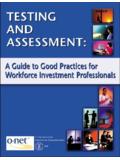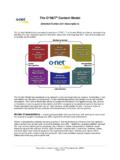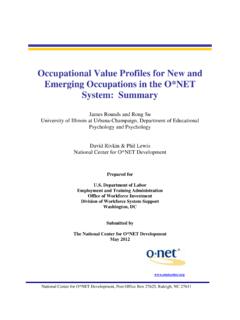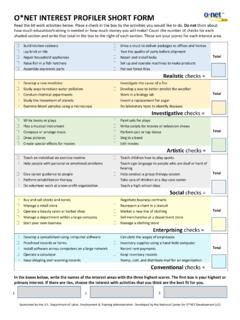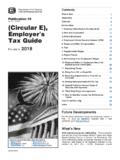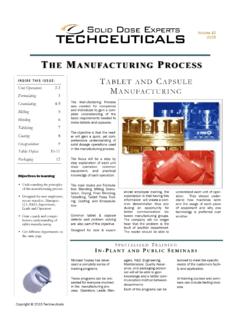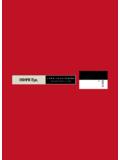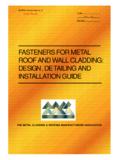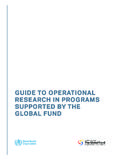Transcription of T E S T IN G A N D A S S E S S M E N T - O*NET Center
1 TESTING AND ASSESSMENT:AN EMPLOYER S GUIDETO GOOD PRACTICES Department of Labor Employment and Training Administration 2000iiiiForewordPURPOSE of the GUIDEIn today s competitive marketplace and complex legal environment, employers face the challengeof attracting, developing, and retaining the best employees. Michael Eisner, CEO of the DisneyCorporation, recognized the impact of personnel decisions on a business bottom-line when heremarked, My inventory goes home every night. This Guide is designed to help managers and human resource (HR) professionals use assessmentpractices to reach their organizations HR goals. It conveys the essential concepts of employmenttesting in easy-to-understand terms so that managers and HR professionals can: Evaluate and select assessment tools/procedures that maximize chances for getting the right fitbetween jobs and employees.
2 Administer and score assessment tools that are the most efficient and effective for theirparticular needs. Accurately interpret assessment results. Understand the professional and legal standards to be followed when conducting of the GUIDEThis Guide is structured around a set of assessment principles and their applications. Theinformation is organized so that readers from a variety of backgrounds will find it to be clear anduseful. Each chapter covers a critical aspect of the assessment process. The issues involved in eachaspect are outlined at the beginning of each chapter. Thirteen principles of assessment are explained in the Guide. The last chapter (Chapter 9)serves as a review by summarizing the main points of the thirteen principles.
3 To assist readers in finding additional information, links to relevant websites are imbedded inthe text throughout the Guide. In addition, Appendix A offers a list of resource materials for those interested in moreinformation on a particular topic. Appendix B is a glossary for quick clarification of terms and Guide is designed to provide accurate and important information regarding testing as part of apersonnel assessment program. It gives general guidelines and must not be viewed as legal and Assessment: An Employer s Guide to Good Practices (Guide) was produced andfunded by the Skills Assessment and Analysis Program in the Department of Labor,Employment and Training Administration, Office of Policy and Research (OPR) under thedirection of Gerard F.
4 Fiala, Administrator. The Skills Assessment and Analysis Program isdirected by Donna Dye, Personnel Research Psychologist, who provided technical direction andsupport for this Guide was prepared under Department of Labor grants with the North Carolina EmploymentSecurity Commission, Southern Assessment Research and Development Center and NationalO*NET Consortium; the New York Department of Labor; and the Utah Department ofEmployment Security. The Guide was completed under the direction of David Rivkin and PhilLewis. Mr. Rivkin also served as editor of the Guide. Authors of this Guide were Syed Saad,Gary W. Carter, Mark Rothenberg, and Enid Israelson. Identification and incorporation of thewebsite links was conducted by Dr.
5 James Rounds and Thomas Smith of the University of Illinoisat Urbana-Champaign. Grateful acknowledgment is made to Laurie Koritko, Patrice Gilliam-Johnson, Jonathan Levine, and Brenda Dunn for their contribution. Thanks are also given to AnnKump, Helen Tannenbaum, Don Kreger, Kristin Fiske, and Marilyn Silver whose valuablesuggestions were very much appreciated. Grateful acknowledgment is also made to SuzanChastain, Department of Labor, Office of the Solicitor, Division of Civil Rights, and Hilary and Cynthia Misicka of the Equal Employment Opportunity Commission forconsultant review and insights into the final preparation of this NoticeMaterial in this publication is in the public domain and may be reproduced, fully or partially,without permission of the federal government.
6 Source credit is requested but not required. Permission is required only to reproduce any copyrighted material contained material will be made available to sensory impaired individuals upon phone: (202) 219-7664 TDD* phone: (800) 326-2577*Telecommunications Device for the DeafivTable of ContentsChapterPage1 Personnel Assessment..1-12 Understanding the Legal Context of Assessment Employment Laws and Regulations with Implications for Assessment..2-13 Understanding Test Quality Concepts of Reliability and Validity..3-14 Assessment Tools and Their Uses..4-15 How to Select Tests Standards for Evaluating Tests..5-16 Administering Assessment Instruments..6-17 Using, Scoring, and Interpreting Assessment Instruments.
7 7-18 Issues and Concerns with Assessment..8-19A Review Principles of Assessment..9-1 AppendixASources of Additional Information on Personnel Assessment..A-1 BGlossary of Assessment Terms..B-11-1 CHAPTER 1 Personnel AssessmentPersonnel assessment is a systematic approach to gathering information about individuals. Thisinformation is used to make employment or career-related decisions about applicants regarding organizations involved with personnel assessment can be found at theInternational Personnel Management Association (IPMA) sites: and Assessment is conducted for some specific purpose. For example, you, as an employer, mayconduct personnel assessment to select employees for a job.
8 Career counselors may conductpersonnel assessment to provide career guidance to and links to various career guidance instruments are available in the ResourceLibrary of America's Career InfoNet at: assessment tools: tests and between the personnel assessment process and tests and do tests measure? do organizations conduct assessment? situations in which an organization may benefit from testing of using tests in a purposeful of personnel tests and procedures fallibility of test scoresPrinciples of Assessment DiscussedUse assessment tools in a purposeful mannerUse the whole-person approach to assessment tools: tests and proceduresAny test or procedure used to measure an individual s employment or career-relatedqualifications and interests can be considered a personnel assessment tool.
9 There are many typesof personnel assessment tools. These include traditional knowledge and ability tests,inventories, subjective procedures, and projective instruments. In this Guide, the term test willbe used as a generic term to refer to any instrument or procedure that measures samples ofbehavior or assessment tools differ in: Purpose, , selection, placement, promotion, career counseling, or training What they are designed to measure, , abilities, skills, work styles, work values, orvocational interests What they are designed to predict, , job performance, managerial potential, careersuccess, job satisfaction, or tenure Format, , paper-and-pencil, work-sample, or computer simulation Level of standardization, objectivity, and quantifiability Assessment tools andprocedures vary greatly on these factors.
10 For example, there are subjective evaluations ofresumes, highly structured achievement tests, interviews having varying degrees of structure,and personality inventories with no specific right or wrong assessment tools used to make employment decisions, regardless of their format, level ofstandardization, or objectivity, are subject to professional and legal standards. For example, boththe evaluation of a resume and the use of a highly standardized achievement test must complywith applicable laws. Assessment tools used solely for career exploration or counseling areusually not held to the same legal between the personnel assessment process and tests and proceduresA personnel test or a procedure provides only part of the picture about a person.
